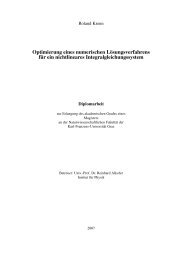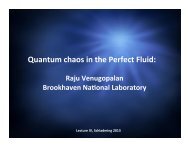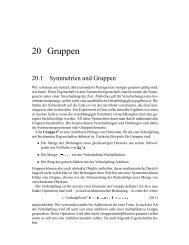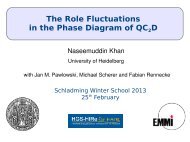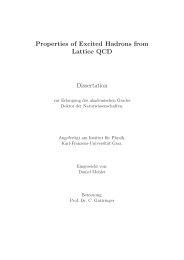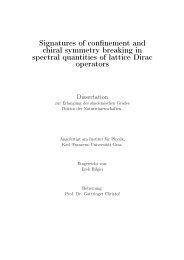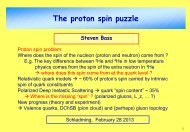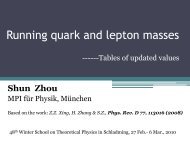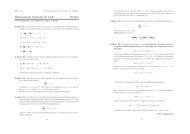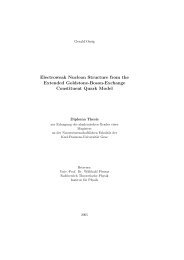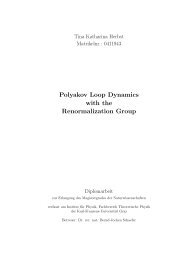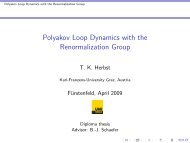The QCD Quark Propagator in Coulomb Gauge and - Institut für Physik
The QCD Quark Propagator in Coulomb Gauge and - Institut für Physik
The QCD Quark Propagator in Coulomb Gauge and - Institut für Physik
Create successful ePaper yourself
Turn your PDF publications into a flip-book with our unique Google optimized e-Paper software.
Chapter 3. Remarks on <strong>QCD</strong> <strong>in</strong> <strong>Coulomb</strong> <strong>Gauge</strong> 33<br />
In this approximation lattice calculations have shown that the Wilson potential signals<br />
conf<strong>in</strong>ement of two static quarks by ris<strong>in</strong>g l<strong>in</strong>early at large R,<br />
V W (R) = σR , (3.91)<br />
where σ is the well-known str<strong>in</strong>g tension. <strong>The</strong> l<strong>in</strong>early ris<strong>in</strong>g energy is stored <strong>in</strong> the<br />
colour electric flux str<strong>in</strong>g connect<strong>in</strong>g the two quarks. If dynamical quarks are present,<br />
which means Det[K] ≠ 1, the creation of a pair of dynamical quarks from the vacuum<br />
is energetically more favourable than the expansion of a str<strong>in</strong>g between the two static<br />
sources. Consequently a pair of mesons is formed at separation R. In this situation the<br />
Wilson potential describes no longer the <strong>in</strong>teraction of two external quarks <strong>in</strong> the vacuum<br />
but the potential of two mesons at separation R <strong>and</strong> can be regarded as an analogue of<br />
a Van der Waals potential. A different quantity should be found, which does not lose its<br />
conf<strong>in</strong><strong>in</strong>g property <strong>in</strong> the presence of dynamical quarks.<br />
Let us review the A 0 A 0 correlator (3.76), which conta<strong>in</strong>s besides the <strong>Coulomb</strong> potential<br />
the quantity<br />
〈<br />
P 0 := −g0<br />
2 (Vρgl ) a (x)(Vρ gl ) b (y) 〉 . (3.92)<br />
It describes the vacuum polarisation <strong>in</strong>duced by the dynamical quarks, where the m<strong>in</strong>us<br />
sign signals that it corresponds to screen<strong>in</strong>g. As we have seen the first term <strong>in</strong> (3.76) is<br />
conf<strong>in</strong><strong>in</strong>g <strong>in</strong> the absence of dynamical quarks. Allow<strong>in</strong>g for those V W constitutes no longer<br />
a conf<strong>in</strong><strong>in</strong>g potential, which <strong>in</strong>dicates that the screen<strong>in</strong>g polarisation term dom<strong>in</strong>ates <strong>in</strong><br />
(3.76). <strong>The</strong> <strong>Coulomb</strong> potential might still be conf<strong>in</strong><strong>in</strong>g, because the long range nature of<br />
V C could be the reason that makes the creation of a dynamical quark pair preferable to<br />
an expansion of the flux tube [CZ02c]. <strong>The</strong> <strong>Coulomb</strong> potential is thus a c<strong>and</strong>idate for<br />
an order-parameter of conf<strong>in</strong>ement <strong>in</strong> the presence of dynamical quarks. Recent lattice<br />
studies [NNST07], however, show that the <strong>Coulomb</strong> str<strong>in</strong>g tension does not vanish for<br />
temperatures far beyond the deconf<strong>in</strong>ement transition, which suggests that the <strong>Coulomb</strong><br />
potential cannot serve as an order parameter.<br />
3.6.4 Conf<strong>in</strong>ement <strong>in</strong> <strong>Coulomb</strong> gauge<br />
When Gribov wrote his famous paper [Gri78] about the problem of gauge copies <strong>and</strong><br />
suggested the possible restriction of the gauge field <strong>in</strong>tegration to the Gribov region Ω, he<br />
already po<strong>in</strong>ted out the possible relation between the restriction to Ω <strong>and</strong> the conf<strong>in</strong>ement<br />
problem by exam<strong>in</strong><strong>in</strong>g the <strong>in</strong>frared behaviour of the ghost propagator. This is given by<br />
the vacuum expectation value of the Faddeev-Popov operator −∇ · D:<br />
D ab (x − y) = 〈M −1 [A]| ab<br />
(x,y) 〉 . (3.93)



